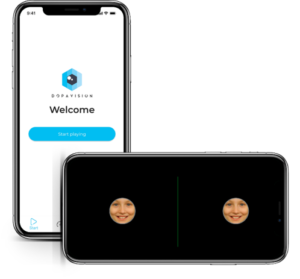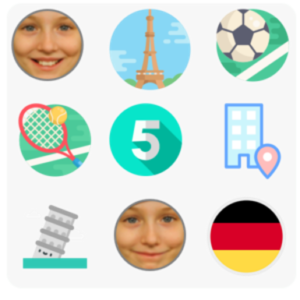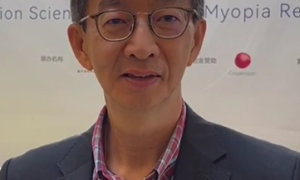November 15, 2021
By Hamed Bahmani, BEng, MSc, PhD
A smartphone application, MyopiaX is a non-invasive digital treatment designed to achieve a medical effect while children play games or view educational content.
Dopavision is developing a novel therapeutic for childhood myopia that can be easily delivered using standard digital devices. The Berlin-based digital health start-up is a pioneer in digital therapeutics in ophthalmology. In the fight against the global myopia crisis, Dopavision aims to provide clinically validated digital myopia control.
Over the past several decades, the prevalence of myopia has been rising rapidly in a so-called myopia boom.1 Myopia, particularly when its onset occurs at an early age, is associated with an increased risk of potentially sight-threatening ocular health complications over the lifespan. There is concern about the growing number of people developing childhood myopia.2 At present, several myopia control methods are available.3 However, there is an urgent need to develop new interventions for childhood myopia control with projections that almost 50% of the global population will have myopia by 2050.4
The Science Behind MyopiaX
MyopiaX is Dopavision’s breakthrough technology that aims to slow the progression of myopia in children and adolescents. A smartphone application, MyopiaX is a non-invasive digital treatment designed to achieve a medical effect while children play games or view educational content. MyopiaX employs a patented, light-based technology to activate a network of cells in the retina to increase retinal dopamine. A vital neurotransmitter in the retina, dopamine contributes to a range of processes, including visual signaling and ocular growth regulation.5 The inhibitory influence of dopamine release on myopia development (i.e., the dopamine hypothesis) is currently a leading myopia control hypothesis, having gained considerable research support since the association was first published in 1989.6
There is also a growing body of evidence for the related light-stimulated release of dopamine hypothesis of myopia control. It is well established that dopamine is released in response to bright light, and research in animal models has demonstrated the importance of normal light exposure for ocular growth regulation. Both dopaminergic compounds and bright light exposure have been shown to inhibit the development of experimental myopia. In children, time outdoors has been found to have a protective effect against myopia. This effect has been attributed to the high illuminance of outdoor light compared to typical indoor lighting and is likely mediated by retinal dopamine release.6
The design of MyopiaX aims to effectively activate the signaling cascade from light exposure to dopamine release. The light stimulation delivered using MyopiaX is hypothesized to efficiently increase retinal dopamine activity to regulate eye growth and slow myopia progression in children and adolescents. Dopavision has conducted a comprehensive set of scientific experiments in collaboration with academic partners around the world in the process of developing and investigating its light stimulus. This research has confirmed proof of concept and generated evidence in preclinical models and exploratory human studies.
A Child-Friendly Digital Therapeutic
MyopiaX has the potential to become the first digital therapy to control childhood myopia. It was developed and tested to provide a user-oriented treatment designed specifically for children. MyopiaX aims to provide a portable and easy-to-use treatment that children can perform under minimal supervision from their parents. The digital treatment is delivered while users play an exciting game that tests their reaction speed, memory, and object recognition. A variety of levels have been created to engage children throughout the treatment, and game development is ongoing. Feedback from usability studies with children and their families has confirmed that the MyopiaX app is easy to use, and the game is fun to play.
Treatment with MyopiaX has been structured to facilitate integrating the activity into existing daily routines. There is evidence from other myopia control approaches that the efficacy of a myopia intervention is related to treatment adherence. As such, children must complete the scheduled daily sessions with MyopiaX to increase the likelihood of receiving the expected clinical benefit. The MyopiaX app logs and displays session performance and completion, making it simple for parents and children to keep track of treatment adherence.
Is the Future of Myopia Control Digital?
Dopavision aims to provide the first digital treatment for children and adolescents with progressive myopia. While some researchers have implicated extended use of digital devices in the recent myopia boom, further work is needed to understand if and how digital screen time contributes to childhood myopia. Yet, digital device use is unlikely to become less common, and eliminating digital screen time among children and adolescents is unrealistic.
MyopiaX is Dopavision’s digital health response to the myopia epidemic and its effort to leverage technology as part of the solution rather than the problem. Technology innovation is expected to play a significant role in the future of health care. A digital approach to myopia control can create significant, far-reaching benefits for children and adolescents with progressive myopia.
Currently, Dopavision is preparing to launch a multicentric randomized controlled trial in five countries across Europe to investigate the safety and efficacy of MyopiaX as a digital approach to slow myopia progression in children and adolescents. The recent closing of a €12 million Series A financing round, led by Seventure Partners and Novartis Pharmaceuticals, will support the clinical investigation of MyopiaX. The funding will also contribute to ongoing research and development activities and educational and cognitive training applications to accompany MyopiaX. Dopavision’s next steps include pursuing CE mark certification of MyopiaX before market launch.

Hamed Bahmani, BEng, MSc, PhD, is founder and managing director of Dopavision and a research scientist with Max Planck Institutes Tübingen.
References
1 Dolgin, E. (2015). The myopia boom. Nature News, 519(7543), 276.
2 Haarman, A. E., Enthoven, C. A., Tideman, J. W. L., Tedja, M. S., Verhoeven, V. J., & Klaver, C. C. (2020). The complications of myopia: a review and meta-analysis. Investigative ophthalmology & visual science, 61(4), 49-49.
3 Wildsoet, C. F., Chia, A., Cho, P., Guggenheim, J. A., Polling, J. R., Read, S., … & Wolffsohn, J. S. (2019). IMI–interventions for controlling myopia onset and progression report. Investigative ophthalmology & visual science, 60(3), M106-M131.
4 Holden, B. A., Fricke, T. R., Wilson, D. A., Jong, M., Naidoo, K. S., Sankaridurg, P., … & Resnikoff, S. (2016). Global prevalence of myopia and high myopia and temporal trends from 2000 through 2050. Ophthalmology, 123(5), 1036-1042.
5 Witkovsky, P. (2004). Dopamine and retinal function. Documenta ophthalmologica, 108(1), 17-39.
6 Zhou, X., Pardue, M. T., Iuvone, P. M., & Qu, J. (2017). Dopamine signaling and myopia development: what are the key challenges. Progress in retinal and eye research, 61, 60-71.















